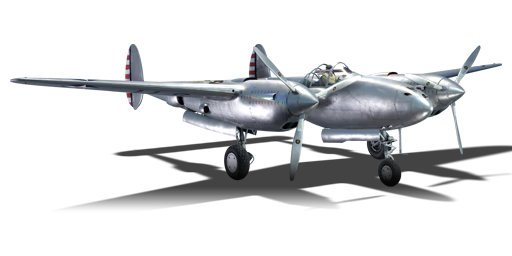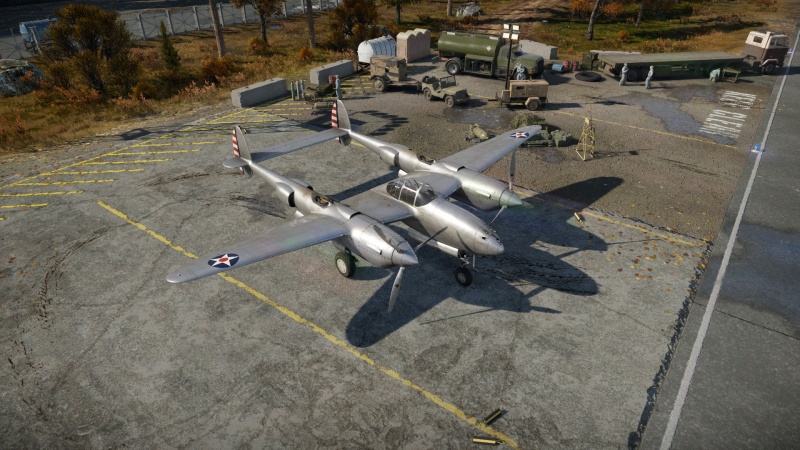YP-38
| This page is about the American twin-engine fighter YP-38. For other versions, see P-38 (Family). |
Contents
Description
The YP-38 is a premium gift rank II American twin-engine fighter with a battle rating of 2.3 (AB) and 3.0 (RB/SB). It was introduced in Update "Raining Fire" when it replaced the XP-38G in the Gaijin store.
General info
Flight performance
| Characteristics | Max Speed (km/h at 7,012 m) |
Max altitude (metres) |
Turn time (seconds) |
Rate of climb (metres/second) |
Take-off run (metres) | |||
|---|---|---|---|---|---|---|---|---|
| AB | RB | AB | RB | AB | RB | |||
| Stock | 613 | 596 | 12192 | 24.0 | 24.9 | 10.7 | 10.7 | 380 |
| Upgraded | 659 | 635 | 22.0 | 23.0 | 16.7 | 13.5 | ||
Details
| Features | ||||
|---|---|---|---|---|
| Combat flaps | Take-off flaps | Landing flaps | Air brakes | Arrestor gear |
| ✓ | ✓ | ✓ | X | X |
| Limits | ||||||
|---|---|---|---|---|---|---|
| Wings (km/h) | Gear (km/h) | Flaps (km/h) | Max Static G | |||
| Combat | Take-off | Landing | + | - | ||
| 790 | 289 | 566 | 495 | 250 | ~10 | ~6 |
| Optimal velocities (km/h) | |||
|---|---|---|---|
| Ailerons | Rudder | Elevators | Radiator |
| < 380 | < 460 | < 500 | > 420 |
Survivability and armour
The pilot has moderate armour protection, but other modules are vulnerable; the critical modules have no armour protection, as the armour is focused solely on the pilot. Because the two engines are on either side of the pilot they could absorb several bullets for the pilot if the enemy comes from the side.
- 38 mm Bulletproof glass - Windshield
- 9.5 mm Steel - Behind pilot's head
- 6.5 mm Steel - Pilot's seat
- 6.5 mm Steel - In front of pilot
- Self-sealing fuel tanks
Modifications and economy
Armaments
Offensive armament
The YP-38 is armed with:
- 1 x 37 mm M4 cannon, nose-mounted (15 rpg)
- 2 x 12.7 mm M2 Browning machine guns, nose-mounted (200 rpg = 400 total)
- 2 x 7.62 mm Browning machine guns, nose-mounted (500 rpg = 1,000 total)
Usage in battles
The YP-38 climbs just as well as a Bf 109, and can make use of a 20 degree sustained climb. However, it cannot turn fight and has quite bad yaw (most likely due to it being twin-engine and having small rudders). Overall, it has bad manoeuvrability, but good acceleration due to having two engines. Make use of the flaps accordingly and you will get better or at least decent mobility in below 190 km/h speed. Due to your good climb rate and slow agility, your best tactic is to hunt bombers. Usually, at this BR, bombers do not climb high or try to speed bomb, bringing them to a low final altitude. You can use your .50 cals and 7.92 mm MGs to shoot out their engines, but it is better to take careful aim and use the 37 mm as its HE shell is quite potent. Depending on armour, it can take 1 to 2, even 3 hits to rip a wing or the fuselage using the HE only belt. These shells have quite slow muzzle velocity compared to MGs but it is worth the time in practising to aim them well as it takes out fighters and twin-engine interceptors like the Bf 110s or Me 410s with a single shot. Against other fighters, it is recommended to fly a Boom and Zoom tactic to any engagement you see fit.
Manual Engine Control
| MEC elements | ||||||
|---|---|---|---|---|---|---|
| Mixer | Pitch | Radiator | Supercharger | Turbocharger | ||
| Oil | Water | Type | ||||
| Controllable | Controllable Auto control available |
Controllable Not auto controlled |
Controllable Not auto controlled |
Separate | Not controllable 1 gear |
Not controllable |
Pros and cons
Pros:
- Good climb rate
- Equipped with a 37 mm cannon
Cons:
- Not very manoeuvrable
History
After the loss of the XP-38 in 1939, the program still showed great potential and, on April 27, 1939 a Limited Procurement Order was placed for thirteen test aircraft. Given serials 39-689-701, the aircraft were designated model 122-62-02 and had many similarities to the final P-38G. Redesigned with Allison V-1710-27/29 (F2R and F2L) boasting 1,150HP and also equipped with B-2 Turbo-Superchargers they featured Spur Reduction Gearing as opposed to the former Epicylical Gearing found on the XP-38. This caused the engines thrust line to be raised upwards, as well the propellers were ,Outward-Rotating rather than Inward-Rotating. (The port propeller rotated Counter-Clockwise when seen from the rear, and the starboard Clockwise). This gave much stability when firing the guns and allowed the aircraft to be a much more effective combat aircraft.
The aircraft's chin-mounted intake under the propeller spinner was also replaced by a pair of cooling intakes, as well as enlarged radiators on both sides of the tail booms. The armament was also revised, substituting two 0.30in. machine guns with two of the four 0.50in. machine guns, and the 37mm Browning M9 was exchanged for a 20mm cannon. With all of the guns mounted in the nose, with the 0.50in. guns mounted above the 0.30in., some YP-38s were observed to have permanent gun enclosure tubes protecting the two 0.50in guns, with flush plates to cover the remaining gun ports. In reality, most of the YP-38s flew unarmed, and due to the structural redesigning, the aircraft was lighter than the XP-38 at 14,348lbs.
On September 16, 1940 the first YP-38 took off with Marshall Headle at the controls, and in March 1940 the Army received it's first YP-38 for trials. With production severely lagging behind, all YP-38 aircraft weren't completed until June of 1941. The aircraft had a maximum speed of 405 Miles per Hour, at 10,000ft, and an altitude of 20,000ft could be achieved in just six minuted from takeoff. With this, the aircraft was exceptional, but had a flaw not seen until it was too late.
The aircraft encountered problems in which, during trials, tail buffet was severe in High Speed Dives. This all came to a head on November 4th, 1941, when Lockheed test pilot Ralph B. Virden took off with the intent to put aircraft 39-689 into High Speed Dive tests. During a dive, the aircraft lost it's tail booms and impacted into the kitchen of a house in Glendale, California, killing Ralph and destroying the aircraft. The accident was initially falsely diagnosed as Elevator Flutter but was soon later solved by the addition of large Wing-Root Fillets at the points where the wings joined the fuselage. The new repair had to be done very specific and precise, as failure of a tight fit would severely impact flight characteristics.
Ralph B. Virden
Born 11, June 1898 in Audobon Township, IL, he was the second child of Hiram R. Virden, a farmer, and Nancy Carrie Ivy Virden. He attended Bradley Polytechnic Institute in Peoria, IL and, on 15, October 1918 at the age of 17, enlisted in the US. Army. With the end of WWI less than a month later, he was quickly discharged, and in 1919 he married Florence L McCullers. Having two children, Kathryn and Ralph Jr., Kathryn unfortunately having passed at the age of 10 in 1930.
In the mid-1920s, Virden flew as a contract mail pilot, holding pilot No. 628, and was employed by Gilmore Aviation and Pacific Air Transport, and for 13 years flew also as a pilot for United Air Lines. In 1939, having racked up over 15,000 flight hours, he was employed by the Lockheed Corporation as a test pilot. Now living in North Hollywood with his son, Ralph Jr., who was also employed at Lockheed, he would unfortunately lose his life in an accident on 4, November 1939 when the tail booms of his Lockheed YP-38 test aircraft, 39-689, separated from the aircraft during a high speed dive test over Glendale, California. Ralph Jr, after the death of his father, would go on to join the United States Navy in WWII.
Crash of 39-689
On November, 4 1941, during a flight over Glendale, California, Lockheed Test Pilot Ralph B. Virden pushed the nose of aircraft 39-689 down to conduct a High Speed Dive test. While in the dive, the aircraft approached what today is known as Critical Mach Number, resulting is air-flow over the wings to reach Transonic speeds and forming shockwaves that interrupted lift causing a portion of the wing to stall. During the dive, the speed reached too great and, in turn, caused the tail booms to separate. Thereafter, the aircraft impacted the house of Glendale resident Jack Jensen at 1147 Elm Street, killing Ralph and igniting a fire. The tail was eventually located several blocks away.
Following the accident, Lockheed, the U.S. Air Corps, and the National Advisory Committee on Aeronautics (NACA) undertook an extensive testing program for the P-38.
Media
- Skins
- Videos
See also
Links to the articles on the War Thunder Wiki that you think will be useful for the reader, for example:
- reference to the series of the aircraft;
- links to approximate analogues of other nations and research trees.
External links
References
- A Brief History of the P-38 "Lightning" (Web Archive)
- This Day in Aviation - Lockheed YP-38 Lightning Archives (Web Archive)
- AAF Manual 51-127-1 - Pilot Training Manual for the Lightening P-38
| Lockheed Corporation | |
|---|---|
| Fighters | XP-38G · P-38E · P-38G-1 · P-38J-15 · Bong's P-38J-15 · P-38K · P-38L-5-LO · YP-38 |
| Bombers | B-34 · PV-2D |
| Jet Fighters | F-80A-5 · F-80C-10 |
| F-104A · F-104C | |
| Strike Aircraft | F-117 |
| Export / License | A-29 · ▄Hudson Mk V |
| ␗P-38L-1 | |
| ␗F-104A · ▀F-104G · ␗F-104G · ▄F-104G · ▅F-104J · ▄F-104S | |
| The Lockheed Corporation merged with Martin Marietta Corporation in 1995 to form Lockheed Martin Corporation. | |
| See Also | SABCA · Mitsubishi Heavy Industries · Fiat Aviation |
| USA twin-engine fighters | |
|---|---|
| P-38 | XP-38G · P-38E · P-38G-1 · P-38J-15 · Bong's P-38J-15 · P-38L-5-LO · P-38K · YP-38 |
| P-61 | P-61A-11 · P-61C-1 |
| F7F | F7F-1 · F7F-3 |
| Other | XF5F · XP-50 · F-82E |
| USA premium aircraft | |
|---|---|
| Fighters | Thach's F2A-1 · Galer's F3F-2 · F2G-1 · F4U-4B VMF-214 · P-26A-34 · Rasmussen's P-36A · P-40C · P-43A-1 |
| P-47M-1-RE · ⋠P-47M-1-RE · P-51A · P-51D-10 · P-51D-20-NA · ␠Kingcobra · XP-55 | |
| ▃A6M2 · ▃Ki-43-II · ▃Ki-61-Ib · ▃Bf 109 F-4 · ▃Fw 190 A-8 · ▃Spitfire LF Mk IXc | |
| Twin-engine fighters | XP-38G · Bong's P-38J-15 · P-38K · YP-38 · P-61A-11 · XF5F · XP-50 · F7F-3 |
| Jet fighters | P-59A · F-86F-35 · F-89B · F-89D · F-4S Phantom II · F-5C · F-20A |
| Strike aircraft | A-1H · A2D-1 · AU-1 · XA-38 · AV-8A · AV-8B (NA) · A-6E TRAM · A-10A |
| Bombers | A-26C-45DT · B-10B · BTD-1 · PBM-3 "Mariner" · PBM-5A "Mariner" · PV-2D |





